Press Releases
FOR IMMEDIATE
RELEASE
Feb. 11, 2010
Contact:
Sarah Marquis
949-222-2212
Robert Schwemmer
805-884-1466
Wreck of Airship USS Macon Added to
National Register of Historic Places
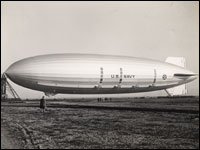 |
| USS Macon attached to mooring mast at Moffett Airfield, California,
(Photo Credit Wiley Collection, Monterey Maritime and History Museum)
Click here for a larger image. |
Commemorating the 75th anniversary of the loss of the U.S. Navy airship USS Macon, NOAA today announced that the wreck site on the seafloor within Monterey Bay National Marine Sanctuary has been added to the National Register of Historic Places.
The Macon, a 785-foot dirigible was one of the largest airships in the world – comparable in size to the RMS Titanic. It was intended to serve as a scout ship for the Pacific Fleet and had the ability to launch and recover Sparrowhawk biplanes. In service less than two years, the Macon, based at Moffett Field in Sunnyvale, Calif.,was damaged in a storm on Feb. 12, 1935, and sank in the Pacific Ocean off Point Sur, south of San Francisco. All but two of the Macon’s 83 crewmen were rescued by nearby Navy ships.
"The USS Macon and its four associated Sparrowhawk biplanes are not only historically significant to our nation’s history, but have unique ties to our local communities, where public museums highlight the airship’s history,” said Paul Michel, Monterey Bay National Marine Sanctuary superintendent. “The National Register listing highlights the importance of protecting the wreck site and its artifacts for further understanding our past.”
The National Register of Historic Places is the nation’s official list of cultural places considered worth preserving. Authorized by the National Historic Preservation Act of 1966, the Register is part of a national program to coordinate and support public and private efforts to identify, evaluate and protect America's historic and archeological resources. Properties listed in the National Register can qualify for federal grants for historic preservation.
The wreckage of the Macon and four aircraft lie at a depth of more than 1,500 feet and were first documented in 1990 by the Monterey Bay Aquarium Research Institute (MBARI). Monterey Bay National Marine Sanctuary and U.S. Navy conducted a sonar survey in 2005 followed by the first archaeological expedition in 2006 that documented the Macon’s remains. The expedition was a collaborative venture involving NOAA's Office of National Marine Sanctuaries, NOAA's Office of Ocean Exploration and Research, NOAA's Preserve America Initiative, MBARI, Stanford University, University of New Hampshire, U.S. Navy, Monterey Maritime and History Museum and the Moffett Field Historical Society and Museum.
The Macon wreck site includes the airship's hangar bay, containing its four Sparrowhawks and their detached landing gear. Five of the Macon's eight engines also have been identified along with objects from the ship's galley, including two sections of the aluminum stove and the enlisted men’s dining table and bench. Aluminum chairs and desks that may have been in a port side officer’s or meteorologist's office also have been found.
“Dirigibles were an important development in the history of aviation and the Macon's remains represent the only archaeologically-documented example of such aircraft in the United States and possibly the world,” said Bruce Terrell, senior archaeologist, NOAA Office of National Marine Sanctuaries Maritime Heritage Program.
The Macon wreck is the second site in Monterey Bay National Marine Sanctuary to be included on the National Register. The wreck of the California Gold Rush side-wheel steamship Tennessee was listed in 1981.
NOAA understands and predicts changes in the Earth's environment, from the depths of the ocean to the surface of the sun, and conserves and manages our coastal and marine resources. Visit http://www.noaa.gov.
On the Web:
Office of National Marine Sanctuaries
Monterey Bay National Marine Sanctuary Macon Expedition
Maritime Heritage Program Macon Expedition
Editor Note:
Photos are available online here.
Media 'B-Roll' is available online:
Historic Stills
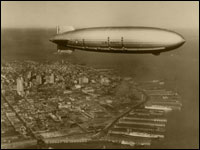 | 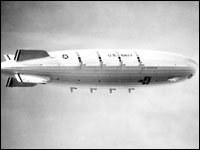 |
| USS Macon in flight over San Francisco in 1934. (Photo Credit: Moffett Field Historical Society)
Click here for a larger image. |
USS Macon in flight with plane in hanger bay on trapez. (Photo
Credit Robert Schwemmer Maritime Library)
Click here for a larger image. |
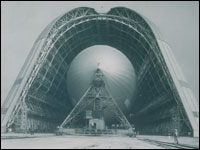 | 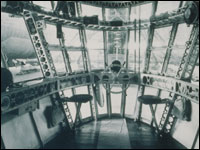 |
| USS Macon inside Hanger No. 1 Moffett Field. (Photo Credit Moffett
Field Historical Society
)
Click here for a larger image. |
USS Macon's navigating bridge inside the control car looking
forward. The rudder control wheel is located in the center between the two seats. The small canvas bag on the right
contains a life-jacket in case of an over water disaster. The duralumin structural frame network is visible throughout
the interior of the airship. (Photo Credit Moffett Field Historical Society
)
Click here for a larger image. |
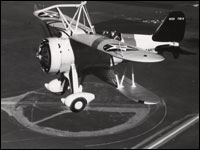 | 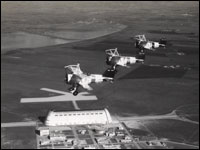 |
| Curtis Sparrowhawk F9C-2 biplane. (Photo Credit Wiley Collection,
Monterey Maritime and History Museum)
Click here for a larger image. |
Curtis Sparrowhawk F9C-2 biplanes. (Photo Credit Wiley Collection,
Monterey Maritime and History Museum)
Click here for a larger image. |
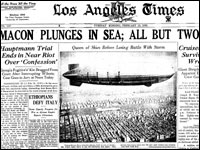 | 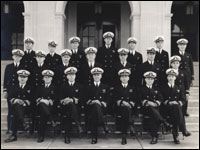 |
| USS Macon Plunges In Sea, All But Two Saved, (Photo Credit Los
Angeles Times)
Click here for a larger image. |
USS Macon's Officer compliment February 1935, (Photo Credit Wiley
Collection, Monterey Maritime and History Museum)
Click here for a larger image. |
Expedition Stills
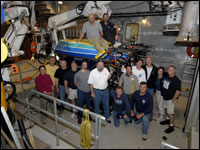 | 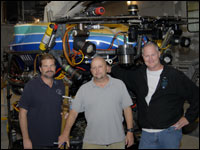 |
| Science team and ROV Tiburon pilots during the 2006 USS
Macon Expedition. (Photo Credit NOAA-MBARI)
Click here for a larger image. |
Co-Principal Investigators (left to right) Robert Schwemme(NOAA), Chris Grech (MBARI) and Bruce Terrell (NOAA). (Photo Credit Erica Burton, NOAA-MBNMS)
Click here for a larger image. |
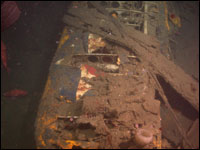 | 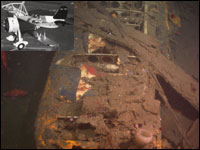 |
| Submerged
view of the port wing of one of four Curtiss Sparrowhawk F9C-2 biplanes recorded at the USS Macon site. (Photo
Credit NOAA-MBNMS/MBARI
)
Click here for a larger image. |
Submerged
view of the port wing of one of four Curtiss Sparrowhawk F9C-2 biplanes recorded at the USS Macon site. (Photo
Credit NOAA-MBNMS/MBARI
)
Click here for a larger image. |
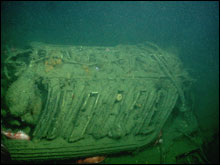 | 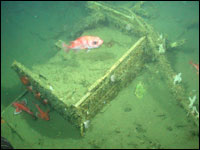 |
| Submerged view of one of eight German built Maybach 12 cylinder
gasoline engines that served as the propulsion system for the airship. During the 2006 expedition five Maybach
engines were located and recorded. (Photo Credit NOAA-MBNMS/MBARI)
Click here for a larger image. | Submerged view of inverted desk drawers with handles, possibly
from the officer' or meteorologist's office located on board the port side of the USS Macon. (Photo Credit NOAA-
MBNMS/MBARI)
Click here for a larger image. |
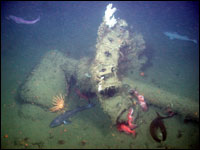 | 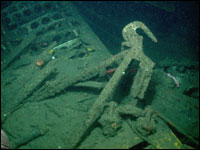 |
| Submerged view of the USS Macon's mooring mast receptacle
assembly, the most forward part of the airship and possibly the last part of the ship to sink. The tapered cone would
mate up with the land based mooring mast. (Photo Credit NOAA-MBNMS/MBARI)
Click here for a larger image. | Submerged view of the sky-hook located at the center of the Curtiss
Sparrowhawk F9C-2 biplane. The pilot during flight would position the aircraft below the USS Macon's hanger where
a trapeze was lowered and the pilot would position the hook onto the trapeze. Sparrowhawk pilots were nicknamed the
"men on the flying trapeze." (Photo Credit NOAA-
MBNMS/MBARI)
Click here for a larger image. |
|





